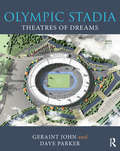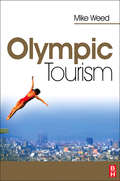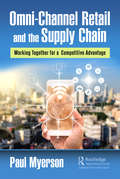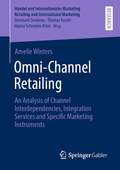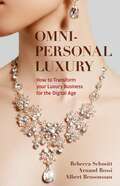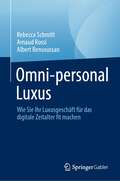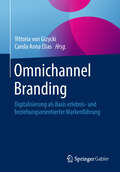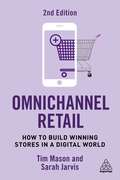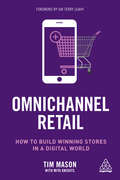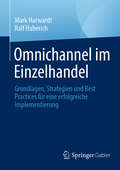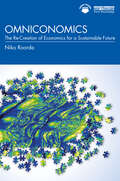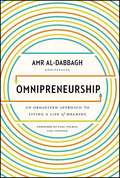- Table View
- List View
Olympic Risks
by Will JenningsThe task of governing the Olympic Games and the Olympic movement now takes place in an age in which states and societies are increasingly organized in response to risk. At the heart of the risk management in organising the Olympics is the tension between the inherent riskiness of mega-events, which is attributable to their scale and complexities, combined with immense societal, political and organisational pressures for the management of risk. Over time, too, staging the Olympics has become more complex, and riskier, as a consequence of its growing scale and commercial success. Since the 1980s, a profound transformation has occurred in how the Games are organised and governed, with the increased transfer of risk to the market and the spread of regulation as a mode of governance and the formal practice of risk management across functions ranging from finance to security to critical infrastructures to public health. This book is a unique theoretical and empirical analysis of how the Olympic Games are governed, exploring the challenges and pressures of staging the world's largest event and the recent emergence of the formal practice of risk management as a response of decision-makers to the operational demands and complexities of the Games.
Olympic Stadia: Theatres of Dreams
by Dave Parker Geraint JohnOlympic Stadia provides a comprehensive account of the development of stadia including but not limited to: developments in running tracks, the introduction of lighting, improvements in spectator viewing standards and the introduction of roofs. Written by a world-renowned expert on sports architecture, the book: Systematically analyses every stadium from Athens 1896 to Tokyo 2020 Provides drawings, plans, elevations, photographs and illustrations in full colour Considers the fundamental changes wrought by the incorporation of the Paralympic Games Looks at the impact on host cities and their urban infrastructure, and considers the long-term legacies and massive investments that Olympic stadia require Explores the effects of the demands of the world’s TV broadcasters. An invaluable and beautiful resource for practical insight and inspiration, this book makes essential reading for anyone interested in Olympic stadia.
Olympic Tourism
by Mike WeedOlympic Tourism is the first text to focus on the nature of Olympic tourism and the potential for the Olympic Games to generate tourism in the run up to and long after the hosting of a Games. The awarding of the 2012 Olympics to London will see an increasing interest in the phenomena of organising, managing and analysing the issues which surround mega-event sport tourism. This text will address these issues and using detailed case analysis of previous and future games, discuss how to maximise the success of managing tourism at these events. Written from an international perspective this text provides the reader with: An exploration of the relationship between sport, tourism and the Olympic Games A guide on how to establish Olympic tourism as a phenomenon that goes far beyond the visits of spectators, athletes, officials and dignitaries during the Games themselves. An examination of the detail of Olympic tourism flows before, during and after the Games Analysis of the requisite partnerships between a range of sport, tourism, Olympic and other agencies to successfully leverage and deliver maximum tourism benefits The tools to draw lessons from case studies of previous and forthcoming winter and summer Olympic Games in the 21st Century A discussion of the potential tourism legacies of the Olympic Games Olympic Tourism is a timely response to this international interest and will be an essential resource for those studying and teaching on sport, tourism and the Olympics.
Olympus Optical Co. Ltd. (A): Cost Management for Short Life Cycle Products
by Robin CooperExplores Olympus Optical's strategic response to major losses in its camera business. Key to Olympus's recovery were its extensive product planning process, a quality improvement program, and an aggressive cost-reduction program. In particular, the case details Olympus's target costing system, which enabled the firm to design high-quality products at low cost.
Oman Beyond the Oil Horizon Policies Toward Sustainable Growth
by Volker Treichel Ahsan S. MansurA report from the International Monetary Fund.
Oman: Banking Sector Resilience
by Pierluigi Bologna Ananthakrishnan PrasadA report from the International Monetary Fund.
Omar Selim: Building a Values-Based Asset Management Firm (A)
by George Serafeim Rebecca M Henderson Shannon GombosAt Barclays Capital, Omar Selim had spearheaded the development of Arabesque-a new socially responsible asset management firm designed to appeal to all investors wishing to invest according to broadly held environmental and social values, as well as to investors wishing to align their investments with their faith. Should Selim give up a very successful career to compete in a highly competitive business, in which it could be very hard to build a differentiated offering? Could Arabesque be something different in the world of asset management? And what role, if any, should values and religious faith play in shaping the firm's products and conduct?
Omar Selim: Building a Values-Based Asset Management Firm (A)
by Rebecca Henderson George Serafeim Shannon GombosAt Barclays Capital, Omar Selim had spearheaded the development of Arabesque-a new socially responsible asset management firm designed to appeal to all investors wishing to invest according to broadly held environmental and social values, as well as to investors wishing to align their investments with their faith. Should Selim give up a very successful career to compete in a highly competitive business, in which it could be very hard to build a differentiated offering? Could Arabesque be something different in the world of asset management? And what role, if any, should values and religious faith play in shaping the firm's products and conduct?
Omar Selim: Building a Values-Based Asset Management Firm (B)
by Rebecca Henderson George Serafeim Shannon GombosThe case describes the decision of Omar Selim to set up Arabesque as an independent organization and how he organized Arabesque to use both financial and environmental, social and governance (ESG) data in order to deliver performance for its clients. Supplement to case 115021.
Omar Simmons: Franchising and Private Equity
by Alyssa Haywoode Steven S. RogersOmar Simmons, managing director of a private equity fund that owns 53 health club units, has to choose: Continue in private equity or shift his career to managing and growing the health clubs. An African-American graduate of Princeton University and Harvard Business School, Simmons has to weigh the financial implications of his choice -- as well as the career implications of whatever he chooses to do. Students will learn about private equity investing, health club franchises, and career decision-making.
Omar Simmons: Franchising and Private Equity
by Alyssa Haywoode Steven S. RogersOmar Simmons, managing director of a private equity fund that owns 53 health club units, has to choose: Continue in private equity or shift his career to managing and growing the health clubs. An African-American graduate of Princeton University and Harvard Business School, Simmons has to weigh the financial implications of his choice -- as well as the career implications of whatever he chooses to do. Students will learn about private equity investing, health club franchises, and career decision-making.
Omics and Genome Editing: Revolution in Crop Improvement for Sustainable Agriculture (Sustainable Landscape Planning and Natural Resources Management)
by Kartika SharmaThis book offers up-to-date research on genome editing and omics technologies from renowned academics with established backgrounds from throughout the globe. The world population is expected to touch 9–10 billion by 2050 and to feed the growing population, 50% more food must be produced globally than is currently produced. Nonetheless, it is a difficult challenge to increase the food output of the currently existing crops on available land. Over the past few decades, traditional crop enhancement techniques like plant breeding and other agricultural technology have made a significant contribution to food and nutritional security. With the use of strong technologies, genome editing strategies can significantly improve the productivity and efficiency of current agricultural practices. Discovering the underlying mechanisms influencing features of economic value has been made possible through genome editing through CRISPR/Cas9, primer and base editing, and OMICs through genomics, proteomics, metabolomics, transcriptomics, and phenomics. This book provides a wealth of information on omics and genome editing approaches and their application to develop abiotic, biotic, and climate-tolerant crops, as well as RNA interference, next-generation sequencing, and metabolomics for sustainable crop production. Researchers are actively using both genome editing and omics for crop improvement; however, there is limited literature offered in a single source. Undergraduate and postgraduate students, researchers, policymakers, and stakeholders will find this book to be an invaluable resource.
Omni-Channel Retail and the Supply Chain: Working Together for a Competitive Advantage
by Paul MyersonOmni-Channel Retail and the Supply Chain The days of going to the local department store to buy a television, view the options available, and make a purchase now seem "quaint." The emergence of the internet, smartphones, social media, and other technologies has opened a world of new options for consumers (and businesses) to review, research, and buy online with an ever-increasing array of delivery options. The emergence of e-commerce has resulted in what is commonly known today as "omni-channel" marketing, in which customers engage with companies in a variety of ways, including in a physical store or online via websites and mobile apps. This process puts the supply chain "front and center," as consumers are increasingly demanding and browsing, buying, and returning goods through various channels, not just the traditional "brick and mortar" way. To accomplish this with high levels of service while remaining profitable requires real-time visibility of inventory across the supply chain and a single view of consumers as they continuously move from one channel to another. While this is a boon to consumers, it has made the already complex global supply chain even more challenging to manage. On top of that, the 2020 Covid19 pandemic has accelerated this omni-channel retail trend, as consumers need even more ways to order and additional options for last-mile delivery, such as curbside pickup. Covid19 has exposed a lack of flexibility and readiness, resulting in shortages of everything from toilet paper and meats to personal protective equipment (PPE) and ventilators. It has been a real-life example of the "bullwhip effect," where variability at the consumer end of the supply chain results in increased variability as one goes upstream towards distributors, manufacturers, and suppliers. This results in shortages, misallocations, and increased costs. No longer can a manufacturer, distributor, or retailer of consumer products just "fill the pipeline" and wait for orders to come in. Now, they must anticipate various purchases and delivery items, while at the same time minimizing costs. To do this is no easy task, requiring a Lean, agile, and responsive supply chain. Until now, there was no existing "playbook" for organizations to navigate their way through this new world. This book describes the impact of omni-channel marketing on the supply chain and logistics functions, and is intended to help management meet the needs of not only today’s ever-changing world but to anticipate what may be required in the future to achieve superior customer service, profitability, and a competitive advantage.
Omni-Channel Retailing: An Analysis of Channel Interdependencies, Integration Services and Specific Marketing Instruments (Handel und Internationales Marketing Retailing and International Marketing)
by Amelie WintersAmelie Winters investigates omni-channel strategies in retail and provides new insights and important implications for researchers and managers based on theoretical considerations and empirical analyses. She shows that retailer should focus on the interdependencies between major purchase channels and emphasizes the need to identify supportive stimuli and cues, such as integration services and online- and omni-channel-specific marketing instruments, to support such transfers and improve behavioral outcomes at the retailer and channel level.
Omni-personal Luxury: How to Transform your Luxury Business for the Digital Age
by Albert Bensoussan Rebecca Schmitt Arnaud RossiRapid shifts in technology and societal changes accelerated by the Pandemic have fundamentally changed the way that customers experience luxury. While digital transformation has unlocked new opportunities to connect one-to-one with customers, the challenge for luxury brands is to engage with customers while protecting their brand equity and leveraging digital tools to build personal relationships with customers. Taking you beyond omni-channel marketing, this book takes a deep dive into the concept of omni-personal, which enables you to connect your brand to relevant and individual experiences. Highly practical in scope, it takes you on a journey to building individual and relevant experiences and relationships at scale. The authors answer the essential questions of who, why, how, what and when omni-personal matters most in luxury, offering best-practice examples, case studies and interviews with industry leaders. Ultimately, this book shows you how to embed the omni-personal strategy into your business and offers a framework to help you assess your organization’s ability to deliver omni-personal marketing along the different channels and touchpoints within the customer journey. This book is for anyone who is interested in the future of luxury, including industry experts and brand managers who want a better understanding of the required steps towards an omni-personal customer relationship.
Omni-personal Luxus: Wie Sie Ihr Luxusgeschäft für das digitale Zeitalter fit machen
by Albert Bensoussan Rebecca Schmitt Arnaud RossiDer rasche technologische und gesellschaftliche Wandel, der durch die Pandemie beschleunigt wurde, hat die Art und Weise, wie Kunden Luxus erleben, grundlegend verändert. Während die digitale Transformation neue Möglichkeiten für den direkten Kundenkontakt eröffnet hat, besteht die Herausforderung für Luxusmarken darin, mit den Kunden in Kontakt zu treten und gleichzeitig ihren Markenwert zu schützen und die digitalen Tools zu nutzen, um persönliche Beziehungen zu den Kunden aufzubauen.Dieses Buch geht über das Omni-Channel-Marketing hinaus und vertieft das Omni-Personal Konzept, das es Ihnen ermöglicht, Ihre Marke mit relevanten und individuellen Erfahrungen zu verbinden. Es ist sehr praxisorientiert und nimmt Sie mit auf eine Reise zum skalierbaren Aufbau individueller und relevanter Erfahrungen und Beziehungen. Die Autoren beantworten die wesentlichen Fragen, wer, warum, wie, was und wann Omni-Personal im Luxusbereich am wichtigsten ist, und bieten Best-Practice-Beispiele, Fallstudien und Interviews mit Branchenführern. Letztlich zeigt dieses Buch, wie Sie die Omni-Personal-Strategie in Ihr Unternehmen einbetten können, und bietet einen Rahmen, der Ihnen hilft, die Fähigkeit Ihres Unternehmens zu bewerten, Omni-Personal-Marketing über die verschiedenen Kanäle und Touchpoints innerhalb der Customer Journey zu betreiben. Dieses Buch richtet sich an alle, die sich für die Zukunft des Luxus interessieren, einschließlich Branchenexperten und Markenmanager, die ein besseres Verständnis für die erforderlichen Schritte auf dem Weg zu einer omni-personal Kundenbeziehung erlangen möchten.
Omnichannel Branding: Digitalisierung Als Basis Erlebnis- Und Beziehungsorientierter Markenführung
by Vittoria Von Gizycki Carola Anna EliasBlankpolierte Markenbotschaften will heute keiner mehr sehen – sie wirken künstlich, standardisiert und verfehlen meist die Bedürfnisse der Kunden. Nur wer in der Lage ist, Daten und Inhalte individuell für den Kunden sinnvoll zu verknüpfen und echte Beziehungen aufzubauen, hat die Chance, zur Love Brand zu werden. Unternehmen stehen deshalb vor der Herausforderung, den Spagat zwischen IT, Customer-Service, Sales und F&E zu meistern und ein sinnhaftes Markenerlebnis zu schaffen. Mit einer 360-Grad-Perspektive aus der Sicht von Unternehmen, Agenturen, Kunden und Wissenschaft zeigt dieses Buch, wie Erlebnispakete – individuell auf den einzelnen User zugeschnitten – über verschiedene Kanäle in Echtzeit kommuniziert werden können. Die Konzepte und Praxisbeispiele machen deutlich, wie Entscheider der Zerrissenheit zwischen unberechenbaren Kunden, Touchpoint-Overkill und Big-Data-Wahn einen klaren Handlungsfokus entgegensetzen können.
Omnichannel Retail: How to Build Winning Stores in a Digital World
by Sarah Jarvis Tim MasonThe retail industry is under significant pressure. Not only are retailers grappling with rising costs, but they are trying to keep up with rapidly changing consumer behaviours, technological advancements and ever-increasing competition.To win, retailers today have to learn how to serve customers equally well both on and offline. This means integrating the physical seamlessly with the digital and creating something that is flawlessly omnichannel as, more than ever, customers are seeking convenient, personalized and unified shopping experiences, regardless of when or where they choose to engage. An omnichannel approach to retail delivers the potential to boost footfall, enhance customer insight, improve service, grow loyalty and ultimately drive sales.Omnichannel Retail serves as a practical guide for businesses on how they can better serve customers to fuel their growth by harnessing the opportunity that being digitally enabled and data-driven brings. This fully updated new edition explains how to build engaging loyalty schemes, deliver personalized marketing and how to maximize the power of customer data. Featuring case studies from omnichannel leaders worldwide such as Asda, Woolworths Australia, Target and Pret A Manger, this book provides tangible and proven examples of how retailers can capitalize on the opportunity that our hyper-connected and always-on world presents.
Omnichannel Retail: How to build winning stores in a digital world
by Tim Mason Miya KnightsAccording to many reports, the physical retail experience is in crisis as more and more consumers shift to internet shopping. Despite this, the majority of global purchases still happen offline, from 90% of sales in the US through to 92% of sales in the UK and 94% in China. The big change is that today's shopper seeks content and advice online before buying in store. Omnichannel Retail celebrates all the advantages of the physical shopping experience, from its sensory selection through to try-before-you buy, and its potential for providing an instant and profitable retail solution, while explaining the imperative of bringing the power of digital and an omnichannel experience to everyday shopping. Connecting the digital customer to the physical customer, Omnichannel Retail delivers a wealth of opportunities for the bricks and mortar store, including an enhanced customer journey, effortlessly tailoring specific products to a particular customer, exploiting surge pricing, upselling lucrative products and above all, building real, and profitable, relationships with your best customers. Based on over thirty years in loyalty marketing, Tim Mason diligently addresses the challenges facing retailers, providing tangible and proven solutions to capitalize on the changing retail landscape.
Omnichannel im Einzelhandel: Grundlagen, Strategien und Best Practices für eine erfolgreiche Implementierung
by Mark Harwardt Ralf HaberichDer Einzelhandel hat sich durch die Digitalisierung in den letzten Jahren dramatisch gewandelt: Das Aufkommen des E-Commerce und die Verbreitung von Smartphones haben das Einkaufsverhalten der Verbraucher revolutioniert. Die Kundinnen und Kunden erwarten heute nicht nur Flexibilität und Bequemlichkeit beim Einkaufen, sondern auch Einkaufserlebnisse, bei denen sie online recherchieren, Produkte in physischen Geschäften ausprobieren und schließlich über die von ihnen bevorzugten Kanäle kaufen können. Die Integration verschiedener Vertriebskanäle ist somit der Schlüssel zum Erfolg im Einzelhandel in der heutigen digitalen Welt. Omnichannel versetzt Einzelhändler in die Lage, diese Erwartungen zu erfüllen, indem sie eine konsistente Markenpräsenz und einen reibungslosen Übergang zwischen den Kanälen gewährleisten.Dieses Buch vermittelt einen praxisnahen und leicht verständlichen Einblick über den Omnichannel-Handel und zeigt Einzelhändlern einen Weg auf, wie sie das Konzept erfolgreich in ihrem Unternehmen implementieren können. Neben einem kurzen Überblick über das veränderte Kaufverhalten von Kundinnen und Kunden erläutern die Autoren die Grundlagen von Omnichannel und zeigen verschiedene Strategien auf. Best Practices erfolgreicher Unternehmen geben wertvolle Tipps und Erkenntnisse, um bewährte Omnichannel-Strategien in die eigenen Geschäftsmodelle zu adaptieren.
Omnichannel im Pharma-Vertrieb: Grundlagen, Benchmarks und Beispiele für den Pharma-Außendienst
by Elke SchwarzDieses Buch zeigt, wie Pharmaunternehmen es schaffen, auch in herausfordernden und volatilen Zeiten mit ihren Produkten die Nummer 1 im Kopf ihrer Kunden zu sein. Neue Rahmenbedingen, die insbesondere durch die Digitalisierung sowie neue Arbeits- und Denkweisen entstanden sind, erfordern sowohl von Führungskräften als auch von Vertriebsmitarbeitern andere Kompetenzen, für die vor allem die Hirnforschung hilfreiche Ansätze liefert.Wie trifft das Gehirn Entscheidungen und wie können Omnichannel-Manager auf Kundenverhalten positiv Einfluss nehmen? Wie kann die Stimme am Telefon als Schlüssel zum Kunden dienen? Auf diese und weitere Fragen gibt das Autorenteam von Branchen- und Trainingsexperten hilfreiche Antworten. Sie erfahren, wie Omnichannel-Vertrieb über die Kanäle Telefon, E-Mail, Vor-Ort-Besuche, Veranstaltungen und Video-Calls erfolgreich gelingt. Zudem lernen Sie Methoden und Skills kennen, wie Sie auch remote effektiv im Team zusammenarbeiten, auf Distanz führen und somit den Omnichannel-Vertrieb langfristig erfolgreich machen können.Die Beiträge bieten eine spannende Kombination aus Theorie und Praxis und zeigen handfeste Erfolgsfaktoren sowie Dos und Don‘ts anhand von Beispielen aus der Pharmaindustrie auf, die sich auf viele Branchen übertragen lassen. Welche Didaktik funktioniert digital und welche nicht? Welche Inhalte lassen sich online vermitteln? Wie kann der Trainingserfolg gemessen werden? Welche Fehler gilt es zu vermeiden? Ein wegweisendes Buch für Führungskräfte in Unternehmen und Branchen mit hohem Weiterbildungsbedarf in Marketing und Vertrieb.
Omniconomics: The Re-Creation of Economics for a Sustainable Future
by Niko RoordaOmniconomics shows how we can make human society intrinsically sustainable, harmonically embedded in nature, with the help of a completely new approach in which traditional economics is transformed. Citing the fallacies of existing economic approaches as directly responsible for many of the environmental and social threats faced by society today, Niko Roorda presents a new, interdisciplinary science: omniconomics. This framework has its foundations in an innovative, joined-up approach, in which all aspects of the natural and social sciences are inextricably linked. It will better allow for new solutions to tackling urgent issues, including climate change, deforestation, environmental and economic inequality, dehumanization, and crumbling social cohesion. Inspiring new thinking, this book aims to: Inspire a public, scientific and political debate about the role of present-day economics, its status as no more than a protoscience, and the consequences for (inter)national policies and developments; Stimulate independent, out-of-the-box thinking of students, graduates, politicians, leaders of society, and any member of the public who worries about the major present-day problems and the future; Stimulate interdisciplinary research within universities towards the creation of an omniconomic science that will replace the discipline of economics and will become a genuine, mature science; Challenge the readers to go beyond short- or middle-to-long term solutions such as the Sustainable Development Goals and circular economy: Omniconomics starts where Doughnut economics ends Encouraging the reader to rethink accepted economic approaches to deal with the present-day threats of global catastrophes, this book will be of great interest to students and scholars of sustainable development, sustainability economics and policies, as well as any practitioners working in related fields.
Omnipreneurship: An Organized Approach to Living A Life of Meaning
by Amr Al-DabbaghAn omnipreneur takes an entrepreneurial approach to every aspect of life—work, family, community, health, finances, spirituality, and more. CEO, past government official, and philanthropist Amr Al-Dabbagh shares his leadership model for using omnipreneurship to improve our lives and our world.
Omnitel Pronto Italia
by Carin-Isabel Knoop Rajiv Lal Suma RajuDescribes the situation faced by Omnitel soon after launching its mobile telecommunication services in Italy in December 1995. Competing against the Italian monopoly, TIM, Omnitel had positioned its services to be better on the quality dimension. However, sales were significantly below expectations. In order to develop a new strategy, Omnitel conducted extensive marketing research. This research identified the varying needs of different customer segments. Omnitel now had to decide whether to attack a new segment with a new service plan, "LIBERO," to improve on past performance.
On Abstract and Historical Hypotheses and on Value Judgments in Economic Sciences: Critical Edition, with an Introduction and Afterword by Paolo Silvestri (Routledge Studies in the History of Economics)
by Luigi EinaudiLuigi Einaudi (1874-1961) was a leading liberal economist, economic historian and political figure. This book provides the English-speaking world with a first critical edition of Einaudi’s – hitherto unpublished – rewriting of one of his most unique and thoughtful essays. The relevance of this essay is crucial from several perspectives: history and methodology of economic thought, role of economics and its relation to other disciplines and to social values, role of economists in the public sphere, while also encompassing the discourse on man and the economist as a "whole man". The critical edition of On Abstract and Historical Hypotheses and on Value Judgments in Economic Sciences includes a comprehensive introduction and afterword. An extensive reappraisal of this newly discovered essay will help to cast light on Einaudi’s uniqueness and originality within and beyond the Italian tradition in public finance, thereby also illuminating his attempt to provide an epistemological account of his long lasting enquiry into the causes of good and bad polities. This book is of great interest to those who study economic theory and philosophy, as well as history of economic thought, public economics and legal and political philosophy.

